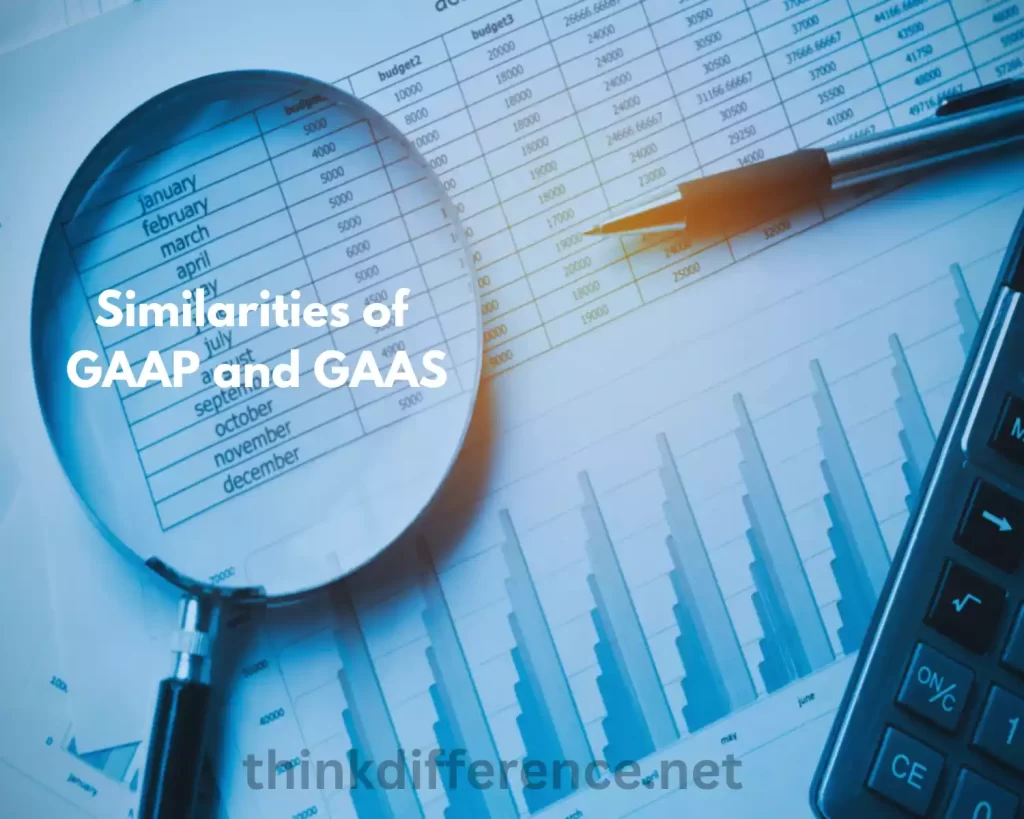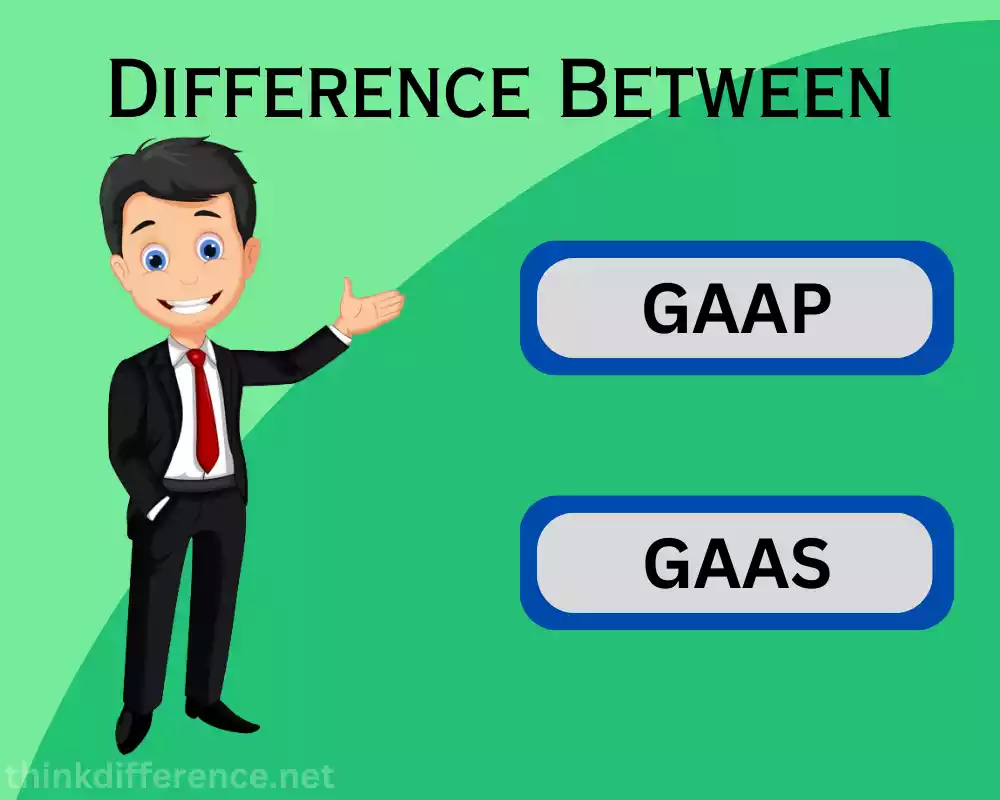What is GAAP?
GAAP (Generally Acknowledged Accounting Principles), are rules used by companies worldwide when creating financial statements and are an international standard used to measure performance across several companies and countries.

Accounting principles, procedures and standards used when compiling these reports follow this set of GAAP rules which isn’t one rule but instead acts as guidelines companies follow when recording and reporting transactions to investors allowing a consistent comparison across nations when looking at company performance data.
What is GAAS?
GAAS (Generally Acknowledged Auditing Standards), provides auditors with guidelines they can follow to ensure their audits of companies are accurate, consistent and verifiable – without missing any key pieces of information – enabling easy comparison between audits from different companies.

GAAS requires auditors to be professional yet independent and proficient ensuring audits with maximum transparency and impartiality are prepared by them.
Understanding the differences between GAAP and GAS is important
All parties involved with financial reporting and auditing should have a firm grasp on the differences between GAAP and GAAS, for many reasons. Here are just a few:
- Roles and Responsibilities: Understanding GAAP from GAAS will help clarify accountants and auditors roles and responsibilities. GAAS is used for auditing financial statements while GAAP guides financial statement preparation. Understanding these roles will ensure that the appropriate professionals are assigned for specific tasks.
- Compliance requirements: Companies are expected to adhere to GAAP for accurate and transparent financial reports, often mandated by law for publicly traded companies. Lenders, investors and regulatory bodies may also demand GAAP-compliant statements; auditors must follow GAAS in order to guarantee financial reports’ accuracy and reliability; it is crucial that businesses understand these regulations in order to satisfy regulatory obligations.
- Effective communication is central to financial reporting: Understanding the differences between GAAP & GAAS will allow all parties involved in the reporting process to communicate more efficiently, helping ensure financial statements prepared according to GAAP are audited according to GAAS auditing requirements, making interactions smoother while decreasing risks associated with misinterpretations or miscommunication.
- Financial Decision-Making: Investors, creditors and regulators depend on accurate financial information in order to make informed choices. Knowing the difference between GAAP & GAAS helps users assess credibility, quality and assurance provided by auditors of financial statements – information necessary for accurately evaluating an entity’s health and performance.
- Audit Transparency and Quality: Auditors play a vital role in providing independent assurance of financial statements. Comprehending GAAS allows auditors to conduct audits with objectivity, integrity and professionalism; helping ensure audit engagements follow standard procedures while providing accurate information to stakeholders – increasing both transparency and audit quality; thus building confidence in financial reporting processes.
- Professional Development: Accountants and auditors need to keep abreast of current industry practices by updating their skillset, knowledge base and skillset with regard to GAAP vs GAAS differences – in order to keep abreast of industry requirements for financial reporting & auditing, better serving clients & stakeholders in doing so.
Understanding the differences among GAAP, GAAS and IFRS is vital for all involved with financial reporting – companies, auditors and users alike. Doing so promotes sound financial decisions while assuring compliance with regulations, enhancing communication channels between financial reporting parties, improving audit quality and supporting professional growth.
How Does GAAS Work?
GAAS (Generally Acknowledged Auditing Standards) provides auditors with guidelines and principles they should abide by when performing audits. Here is how GAAS is implemented:
- Establishing the Audit Goal: The initial step of any audit process involves setting an audit goal. This involves setting out its purpose and scope, understanding of client business operations, industry environment and risks as part of this step.
- Audit Planning: Auditors carefully consider factors such as scope, timing and nature of audit procedures when planning audits for clients. This process may include assessing their internal control system as well as identifying any key accounts or assertions which need further scrutiny as well as creating an audit plan designed to address identified risks.
- Gathering Audit Evidence: Auditors conduct audit procedures in order to collect sufficient and sufficient audit evidence from clients’ financial systems and records, testing controls, substantive procedures and substantive procedures as necessary.
- Evaluation of Audit Findings: Once they have collected evidence for an audit, auditors examine its findings to ascertain the fairness of financial statements. They analyze materiality and impact of any misstatements found as well as any relevant disclosures that need to be included in financial reports.
- Forming an Audit Opinion: Auditors form an audit opinion based on their evaluation of audit findings. An auditor may form either an unqualified, adverse, qualified or disclaimed audit opinion depending on how he/she assessed them.
- Reporting and communication: Auditors create an audit report to convey their opinion to clients and other stakeholders, outlining scope, audit procedures, findings, opinion and any recommendations made during an inspection. Auditors may also send letters to management in order to identify weaknesses or improvement areas that need further examination.
- Quality Control: Auditors have the duty of maintaining an effective quality control system to ensure audits comply with GAAS. This should include policies and procedures to guarantee independence, competence and objectivity of audit engagements as well as review and supervision services for them.
- Professional Skepticism & Judgment: When conducting audits, auditors rely on both professional skepticism and professional judgment as essential components of their auditing practice. Professional skepticism helps maintain an alertness to possible material misstatements while professional judgment allows auditors to use their knowledge and expertise in making informed decisions with accuracy and clarity.
GAAS provides auditors with an effective framework to conduct audits with integrity, professionalism, and independence. GAAS increases credibility and reliability of audit engagements as it gives stakeholders assurances regarding accuracy and fairness in financial statements.
How Does GAAP Work?
GAAP (Generally Acknowledged Accounting Principles) provides companies with a framework to present and prepare financial statements in a consistent, comparable, and reliable way. Here’s how it’s used:
- Standard-Setting Bodies: In the United States, standard-setting bodies such as the Financial Accounting Standards Board update and establish GAAP. These bodies also create accounting standards and guidelines based on both business developments as well as user needs of financial statements.
- Accounting Standards: The GAAP is a set of accounting standards which provides rules and principles to record, measure, present and disclose financial transactions and events. This standard addresses topics such as revenue recognition, expense recognizing, asset valuation liability equity presentation.
- Generally Accepted Accounting Principles (GAAP): GAAP serves as the foundation of generally accepted accounting principles (GAAP), which are accounting concepts and assumptions which guide financial statement preparation. Examples include accrual accounting, the going concern assumption and consistency.
- Financial Statement Elements: GAAP provides guidance for recognizing and measuring various elements of a financial statement such as assets and liabilities, equity, income expenses gains losses etc. It establishes criteria and methods to value these components of an account to ensure consistency across industries and companies.
- Disclosure Requirements: GAAP includes disclosure requirements that mandate companies provide additional information, clarifications and details to provide readers with a greater understanding of a company’s financial situation, performance, important accounting policies as well as any relevant details. These disclosures give users more clarity into the financial state of affairs for the company in which they invest.
- Consistency and Comparability: GAAP promotes consistency and comparable financial reporting by assuring similar transactions are recorded and presented consistently across periods and entities, enabling users to compare statements across companies over time.
- Industry-Specific Guidelines: GAAP provides tailored industry guidance to specific industries such as banking and insurance, healthcare and non-profits. GAAP contains rules and principles tailored specifically for these specialized fields that may have unique reporting and accounting requirements.
- Compliance With Regulation: In many jurisdictions, public companies must abide by GAAP. Even private companies must ensure their financial reporting is transparent and accountable, meeting regulatory compliance by adhering to GAAP and providing accurate financial information.
- Auditing and Assurance: Auditors depend on compliance with GAAP to conduct audits. GAAP serves as the framework through which auditors evaluate financial statements’ accuracy and fairness.
GAAP (Generally Accepted Accounting Principles) is a set of comprehensive rules, principles, and guidelines which regulates the preparation and presentation of financial statements. Financial reporting that adheres to GAAP provides more reliable reporting. In addition, transparency and comparability are increased. GAAP compliance ensures regulatory compliance, accountability, and transparency – these three essential qualities make for quality financial reporting.
Differences Between GAAP and GAAS
GAAP and GAAS differ substantially, here are the primary differences:
- Purpose: The purpose of GAAP and GAAS remains the same – to produce accurate and trustworthy financial statements.
- Scope: GAAP and GAAS both focus on different aspects of financial reporting, preparation and presentation vs audit. Although both standards share similar qualities, their respective focus areas lie elsewhere within financial reporting.
- Authority: The Financial Accounting Standards Board, (FASB) and Public Company Accounting Oversight Board, (PCAOB). FASB, an oversight body to FASB itself, oversees both boards, PCAOB was formed under Sarbanes-Oxley in 2002 as a public body overseen by both bodies.
- Applicability: GAAS applies only to auditors of financial statements while GAAP applies only to companies which prepare and present their financial statements publicly. Private companies do not need to adhere to GAAS even when audited by PCAOB-registered accountants.
- Standards: GAAP stands for “Generally Accepted Accounting Principles and Principles”, while GAAS refers to auditing standards. GAAP includes topics like revenue recognition, inventory valuation and financial statement presentations while GAAS includes planning and evidence gathering processes.
- Compliance: Companies must abide by GAAP in order to produce accurate financial statements; auditors, must observe GAAS for conducting audits that adhere to professional standards.
GAAP and GAAS both represent important standards used for financial reporting and auditing. Although both have some similarities, each standard serves different purposes and has unique purposes and scope requirements.
Similarities of GAAP and GAAS
GAAP and GAAS share many similarities despite having different applications and purposes:
- Framework: GAAP and GAAS provide a foundation for financial reporting and auditing, providing guidelines, standards, and principles which promote consistency, comparability, and reliability among financial statements and audits.
- Professional Organizations: GAAP is developed and maintained annually by accounting and auditing professional organizations. In the US, this responsibility lies with the Financial Accounting Standards Board; while American Institute of Certified Public Accountants’ Auditing Standards Board sets GAAS. Internationally known frameworks like International Financial Reporting Standards and International Standards on Auditing provide global frameworks for financial reporting and auditing practices.

Figure 03: Similarities of GAAP and GAAS - Importance of Professional Judgment: GAAP (General Accounting Principles) and GAAS (General Accounting Standards) both recognize the need to exercise professional judgment when applying them, specifically accounting and auditing professionals must use such judgment in interpreting and applying standards or principles when dealing with particular scenarios.
- Relevance to Stakeholders: Both GAAP and GAAS were designed to meet the needs of all stakeholders, such as investors and creditors. GAAP provides relevant, dependable information about financial statements for these users while GAAS guarantees them as to its reliability and fairness.
- Standard Revisions and Updates: Both GAAP (General Accounting Principles) and GAAS (General Accounting Standards) undergo periodic reviews and updates by standard-setting bodies, in order to stay relevant and effective. As business practices, economic conditions, and regulatory requirements evolve over time, these standards need to adapt as necessary. Regular updates help keep them attuned with changing business needs.
- Regulatory Compliance: GAAP compliance is mandatory for public companies, while GAAS audit compliance must be met by auditors who perform audits. Both GAAP and GAAS play an essential role in assuring regulatory compliance and the integrity of financial reporting.
GAAP and GAAS share certain similarities, yet understanding their respective purposes and applications is vital to producing accurate financial reports and reliable audit engagements.
Final Words
Both GAAP and GAAS play vital roles in accounting. Financial statements must first be prepared according to GAAP before being verified using GAAS as they complement one another perfectly.
Auditors find it easier to audit financial statements prepared according to GAAP, otherwise it could become challenging. Without GAAS statements for verification purposes auditors could find the process more cumbersome or time consuming.



